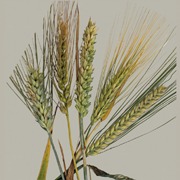- Record: found
- Abstract: found
- Article: found
Genetic pathways controlling inflorescence architecture and development in wheat and barley

Read this article at
Abstract
Modifications of inflorescence architecture have been crucial for the successful domestication of wheat and barley, which are central members of the Triticeae tribe that provide essential grains for the human diet. Investigation of the genes and alleles that underpin domestication‐related traits has provided valuable insights into the molecular regulation of inflorescence development of the Triticeae, and further investigation of modified forms of architecture are proving to be equally fruitful. The identified genes are involved in diverse biological processes, including transcriptional regulation, hormone biosynthesis and metabolism, post‐transcriptional and post‐translational regulation, which alter inflorescence architecture by modifying the development and fertility of lateral organs, called spikelets and florets. Recent advances in sequencing capabilities and the generation of mutant populations are accelerating the identification of genes that influence inflorescence development, which is important given that genetic variation for this trait promises to be a valuable resource for optimizing grain production. This review assesses recent advances in our understanding of the genes controlling inflorescence development in wheat and barley, with the aim of highlighting the importance of improvements in developmental biology for optimizing the agronomic performance of staple crop plants.
Abstract
This review summarizes the recent advances on the genetic regulation of inflorescence architecture in the Triticeae tribe, including the staple crops of wheat and barley. We focus on the key domestication related traits, and recent studies that have used modified forms of inflorescence architecture to identify genes regulating spikelet and floret development.
Related collections
Most cited references48
- Record: found
- Abstract: found
- Article: not found
A microRNA as a translational repressor of APETALA2 in Arabidopsis flower development.
- Record: found
- Abstract: not found
- Article: not found
Crops that feed the world 10. Past successes and future challenges to the role played by wheat in global food security
- Record: found
- Abstract: found
- Article: not found
